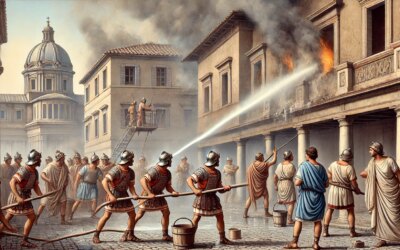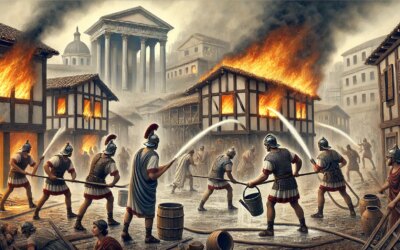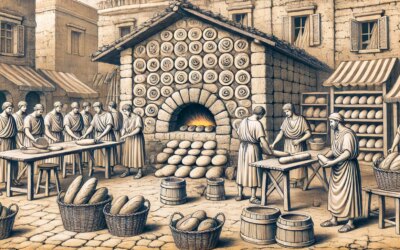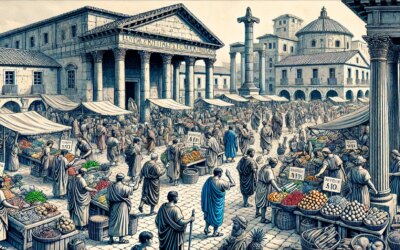Guardians of the Night: Rome’s First Responders
In the maze-like streets of 1st century AD Rome, danger often came not from invading armies, but from within: fire, theft, and urban unrest. To confront these threats, Emperor Augustus established one of the world’s earliest organized emergency services—the Vigiles Urbani. Known simply as the Vigiles, this corps of watchmen, firefighters, and night patrols became an essential force in maintaining order in the world’s most populous city.
The Birth of the Vigiles
Before Augustus’ reforms, fire control in Rome was haphazard and largely dependent on private efforts. Rich citizens often hired their own fire brigades, and opportunistic entrepreneurs sometimes charged desperate residents exorbitant fees for extinguishing fires. Recognizing the danger to public safety and the potential for civil disorder, Augustus created the Vigiles in 6 AD—organizing them into a permanent, salaried force under imperial control.
This new institution, comprising roughly 7,000 men, was divided into seven cohorts, each responsible for two of Rome’s 14 administrative regions. Their motto was vigilance and speed—qualities essential in a city where wooden structures and oil lamps turned negligence into disaster overnight.
Structure and Duties
The Vigiles functioned as both firefighters and night watchmen. Each cohort included centurions, junior officers, and rank-and-file firefighters. Their duties included:
- Firefighting: Using siphones (hand pumps), buckets, axes, and blankets soaked in vinegar, the Vigiles doused flames and demolished buildings to create firebreaks.
- Patrolling: Night patrols maintained order in the streets, detained criminals, and assisted in locating lost persons or goods.
- Inspections: The Vigiles conducted checks on insulae (apartment blocks), looking for fire hazards and enforcing building codes.
- Emergency Response: They were often first on the scene during natural disasters, riots, or building collapses.
Command was centralized under the praefectus vigilum, a high-ranking official appointed by the emperor. Though originally composed of freedmen, the corps grew in prestige, and its members were later drawn from citizens and even received military-style ranks.
Tools of the Trade
Firefighting in ancient Rome was a physical and risky endeavor. The Vigiles employed:
- Water buckets passed in chains by hand.
- Siphons that operated like early pumps to spray water onto flames.
- Hooks and axes to tear down burning walls or roofs.
- Mattresses soaked in water thrown onto fires to smother them.
They also used fire horns to alert citizens of danger, and carried torches for night patrols, ironically increasing fire risk but necessary for visibility. Their barracks were strategically placed across the city, often doubling as watchtowers.
Notable Fires and the Vigiles’ Response
Despite their efforts, fires continued to plague Rome. The most infamous blaze—the Great Fire of 64 AD under Emperor Nero—raged for six days, destroying large parts of the city. Though the Vigiles fought bravely, their numbers and tools were inadequate against the scale of the inferno. The disaster prompted further reforms, including stricter building codes and wider streets to serve as firebreaks.
In other incidents, such as the fire of 80 AD under Titus, the Vigiles earned praise for saving lives and controlling the spread. Their presence also helped reduce opportunistic crime during emergencies, as looting was a common threat during evacuations.
The Social Role of the Vigiles
The Vigiles were more than just an emergency response team—they were a vital part of Rome’s urban culture. They interacted with citizens nightly, enforced curfews, and mediated local disputes. For the poor, who lived in flammable insulae, the Vigiles were often the only protection against sudden disaster.
They also assisted magistrates, helped with crowd control during festivals, and guarded public spaces like the Forum and markets. Over time, they developed into a quasi-police force, particularly as the empire expanded and cities grew more complex.
Decline and Legacy
The Vigiles continued to operate through the Severan dynasty and into the 3rd and 4th centuries. As the Western Empire declined, their effectiveness waned, and local militias or Christian institutions began to take over their roles in some areas. In the Eastern Roman Empire (Byzantium), similar urban forces persisted under different names.
Today, the Vigiles are recognized as one of the earliest examples of a professional firefighting and public safety corps in human history. Their model influenced later medieval and Renaissance city services, and their legacy lives on in the very word “vigilant.”
Watching Over the Eternal City
In the flickering torchlight of ancient alleyways, the Vigiles kept Rome safe while the city slept. They were not always successful, but their presence brought a sense of order to an unpredictable world. Their courage, resolve, and innovation helped sustain the life of the city—and set a precedent that echoes in every modern fire brigade and urban watch across the globe.






